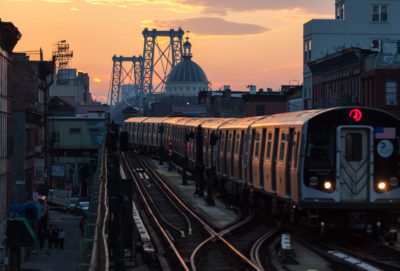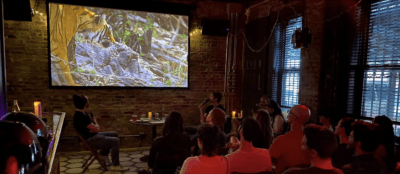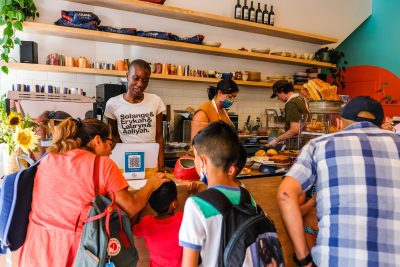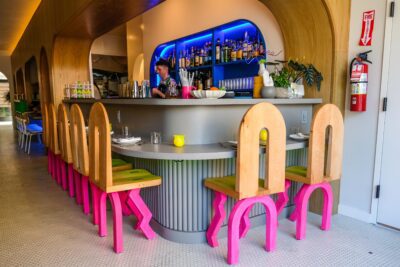Berhe-Lumax, right, and a volunteer (Photo: Mags Chmielarczyk)
‘Take what you need’: Inside City Harvest’s mission to keep community fridges stocked
Hundreds of community fridges were established during the pandemic. Keeping them full is another challenge entirely
A City Harvest van pulls up to a little fridge on the sidewalk in Clinton Hill and a team of volunteers fills it with dozens of fresh apples. Over the course of the next hour, three passing neighbors stop by to grab the fruit, eat it or save it for later.
The One Love Community Fridge has sat on Myrtle Avenue for over a year and supplied the neighborhood with free produce. With an inviting graphic printed on the door, the fridge beckons passersby to “Take what you need, leave what you can.”
To mark World Food Day on October 16, New York’s largest food rescue organization City Harvest is spending the week stocking more than 80 community fridges across the five boroughs with fresh food. The Comida Gratis campaign—a partnership with Showtime (a Brooklyn Magazine advertiser), Desus & Mero, and NY Forever—aims to raise awareness about food insecurity and inspire community support.
Community fridges have been popping up on sidewalks across the city since early 2020. Asmeret Berhe-Lumax, the founder of One Love, was motivated by the fact that food pantries were overwhelmed; people were risking exposure to Covid while standing in long lines, and fresh, nutritional food was rarely on offer.
So Berhe-Lumax plonked a fridge down on the sidewalk and started out by stocking it herself.
“That’s the amazing thing about community fridges,” Berhe-Lumax says. “It provides a space for anyone to participate. No matter how much you have to give, or how much time you have–there is a space for everyone. Our mission is really about engaging and empowering community members in the process, and one of our tools is the community fridges.”
Now, by partnering with local businesses and farmers, the One Love team is able to distribute thousands of pounds of food to a network of fridges across Brooklyn—an effort that simultaneously minimizes waste and provides direct access to healthy groceries. Both crowdfunded donations and local volunteers keep the project running.
Food insecurity has always been a pervasive issue in New York, but the pandemic and surging unemployment has exacerbated the hunger crisis. Food insecurity has increased by 36 percent over 18 months, and more than 1.5 million New Yorkers are struggling to feed themselves and their families, according to City Harvest. It is no secret that when the governmental response to pandemic insecurity faltered, charitable organizations and mutual aid groups rallied to fill the gap.
“The mission of City Harvest is twofold,” says Jenique Jones, the vice president of program operations at City Harvest. “We know that there is good food out there that goes to waste. The world throws away billions of pounds of food that was perfectly good to eat, and yet we have so many people who go to bed every night hungry.”
City Harvest has spent decades combating systemic scarcity by rescuing food and delivering it to food pantries and community partners throughout the city. Their origins, like the One Love project, are distinctly grassroots: they started out as a few volunteers funneling food from restaurants to food pantries on foot. Now in its 39th year, City Harvest has 26 trucks, 160 staff members, and thousands of volunteers.
By the weekend, the organization will drop 200 pounds of food at each community fridge—there’s one plugged into a tire shop in the Bronx and others tucked behind bodegas in Bed-Stuy. This is the first time an organization has attempted to fill the fridges en masse, and they hope the campaign will draw local engagement with community fridges across the city.
“We want to bring awareness to these really amazing community partners who are seeking to do what we do—to feed their neighbors,” says Jones.
Nurturing a future
Community involvement is essential to operating a sustainable community fridge. Although mutual aid garnered a huge amount of attention during the first lockdown, ongoing support from local community members is what truly keeps the fridges afloat. As journalist Matthew Sedacca points out in The Counter, the most effective community fridges are also embraced by those who engage with their fridges as social hubs.
“At the Fort Greene Community Fridge in Brooklyn, volunteers say that the same people who rely on the fridge for their daily meals, or to fill their own fridges and pantries at home, have also helped maintain the space and used it as a place to connect with their neighbors,” writes Sedacca.
Berhe-Lumax leans into this reciprocal relationship.
“It’s easy to put up a fridge. It is more difficult to actually create a community around it. And the most difficult is ensuring that the fridges are stocked” she says. “Last year, there was a lot of press around community fridges. Everybody was getting involved. Right now, businesses are opening up again and people’s schedules are getting busier. People are starting to forget that a huge percentage of our population is still food insecure, and this work still needs to keep going.”
View this post on Instagram
Looking for a community fridge near you? This map pinpoints all the mutual aid-operated fridges in the city (along with their contact information).
You might also like 


























